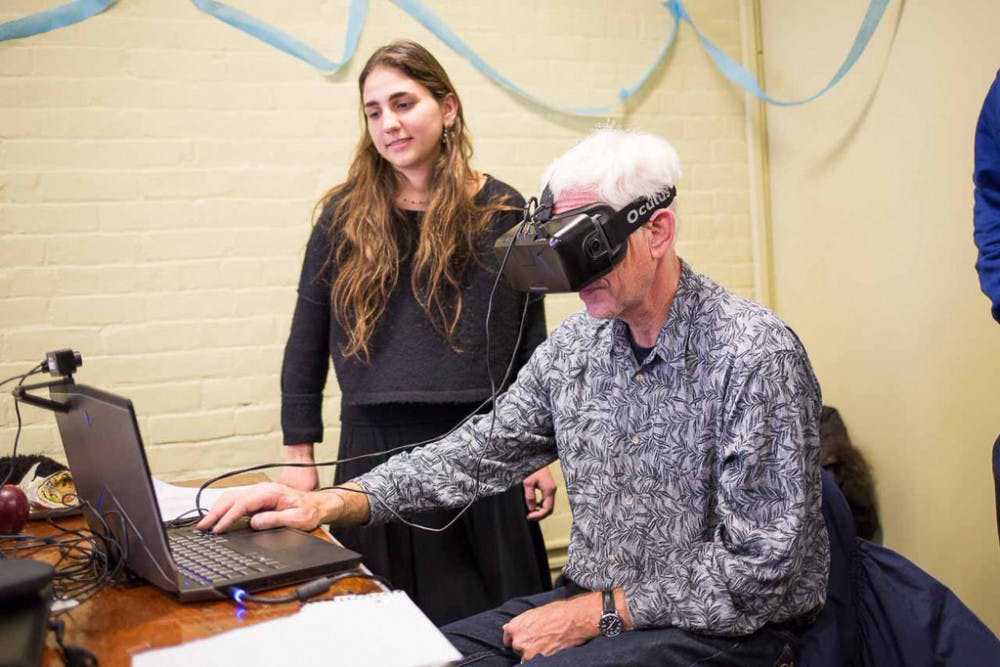Over 450 students from across the world filed into Sayles Hall Saturday, introducing themselves to one another and buzzing with excitement as they awaited the opening ceremony of the third annual Hack@Brown. The hackathon brings students and professionals together to “hack” at projects and problems over the span of 24 hours.
Keynote speaker Karen Smith Catlin ’85 P’18 welcomed the crowd by advising them to try new things and get out of their comfort zones, while both Gov. Gina Raimondo and Chief Innovation Officer for the State of Rhode Island Richard Culatta encouraged students to create something that would help other people.
“I strongly believe that code is world-changing and can tackle problems of society,” Culatta said.
Since its inception in January 2014, Hack@Brown has grown from an organizing team of 12 to 53. While it used to occupy only Alumnae Hall, this year’s event took over Salomon, Sayles and Wilson Halls.
In just under 24 hours, students formed teams, developed plans, attended workshops and wrote code to turn their ideas into reality — a tangible app, website or device, among others. All projects were presented at noon Sunday to judges. The winning team created Ideaback, a brainstorming tool that allows users to “map ideas and crowdsource feedback in real-time,” according to the team’s slogan.
Many teams created tools for entrepreneurs. One of the 15 finalist teams created an app called Funder. Inspired by the dating app Tinder, Funder matches entrepreneurs with investors through brief elevator pitches and connects them through Google Hangouts if the two swipe right on each other, said Oscar Lafarga, one of the team members and a graduate student at the University of Southern California.
Rebecca Schofield from Texas A&M University and Sebastian Poveda from the University of Texas at Dallas created a prototype of a gadget that can help the elderly — particularly those with Alzheimer’s disease — find a lost phone by physically guiding them to the device, Poveda said.
Paige Selby GS, Katie Wen and Emily Fang from RISD created Fitpup — an app inspired by Tamagotchi that syncs a virtual pet to a fitness tracker as a way to incentivize exercise. The team tried to integrate fun with exercise, as opposed to “a lot of fitness trackers that are stat-oriented and very serious,” Fang said.
The event was designed to be inclusive, said Sharon Lo ’16, co-director of Hack@Brown. Approximately 50 percent of the participants were female, and racial diversity reflected national demographics, she said.
In total, 84 different schools were represented, and participants were selected through a weighted random lottery, said Athyuttam Reddy ’17, a co-director of the event. For nearly half of the students, Hack@Brown was their first hackathon, Reddy said.
“We think the diversity aspect is so important because technology is growing and shifting,” Lo said. “It’s really important that the people working on technology are diverse, or else the products they make won’t fit the diverse needs of the population.”
Twenty-six software and technology companies — including Microsoft, pMD, Bracket Computing and Two Sigma — were present at the event. Representatives from many companies were Brown alums and attended as mentors to assist students with technological support.
Though smaller prizes such as “Best User Experience” and “Best Data Visualization” are awarded to teams in addition to the overall winning project, the purpose of Hack@Brown is to learn, Lo said.
“We wanted to break the stereotype and create a welcoming environment where people aren’t there for the competition or for the prizes or to prove that they’re legendary hackers,” Reddy said. “We shy away from (the grander prizes) on principle because we think that’s the wrong incentive.”
Students and mentors noted that they were impressed by the fluid organization of the event and the coordinating team’s attention to detail, especially given that the number of participants exceeded 500.
Peter Norvig ’78 P’16 P’18, director of research at Google, closed the event and commended the students on “demonstrating great flexibility” in combining technologies to create something new, while Evan Stites-Clayton ’11, co-founder of Teespring, encouraged students to take advantage of the learning opportunities presented to them on campus and beyond.
“You won’t find an environment that encourages learning and self-improvement more than you will here at Brown,” Stites-Clayton said.





